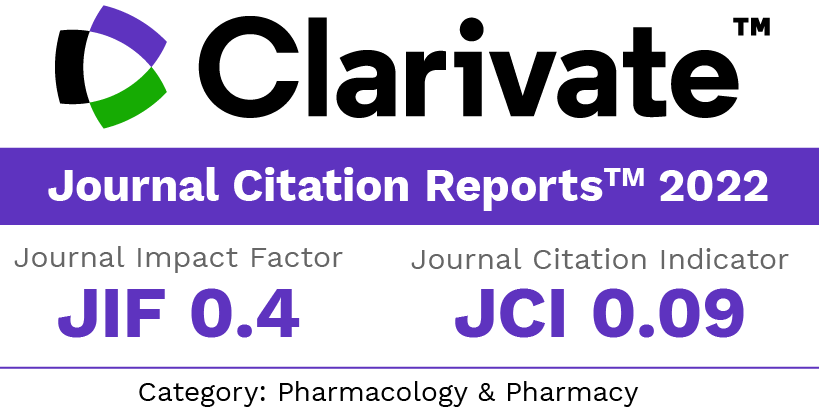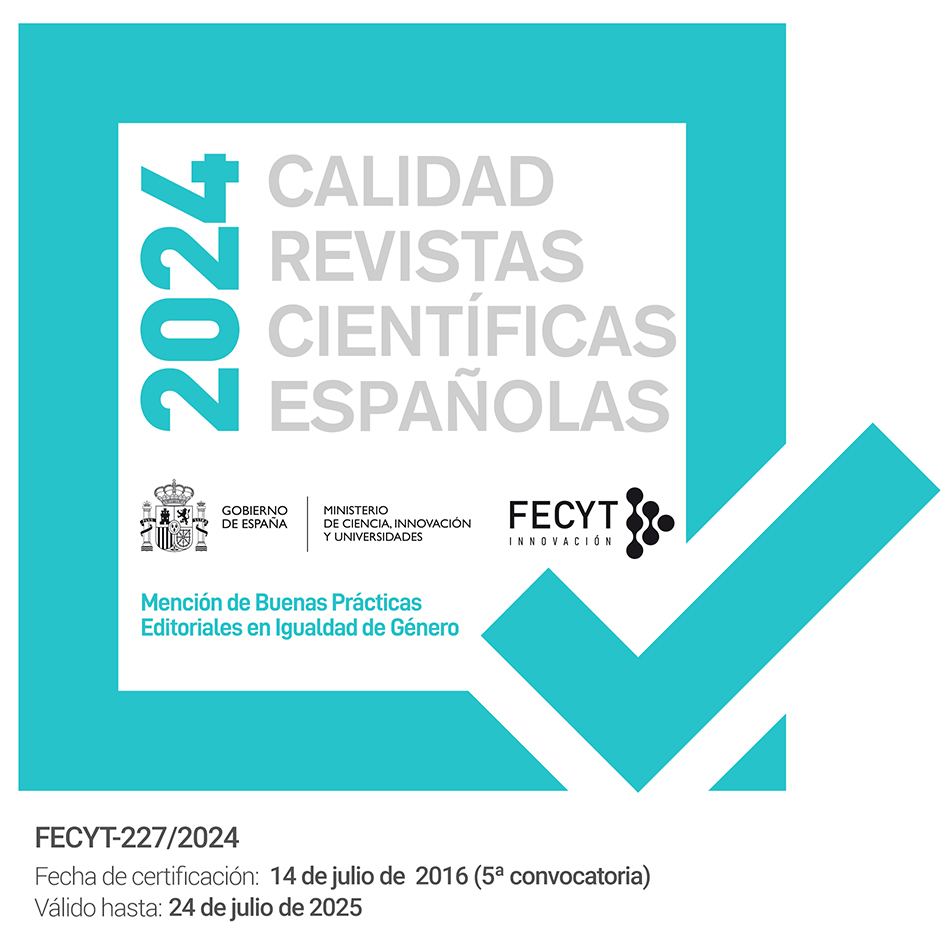Evaluaciones toxicológicas de un extracto acuoso del alga marina Bryothamnion triquetrum (Gmelin) M.A.Howe en estudios in vitro y modelos animales.
Palabras clave:
Evaluaciones toxicológicas, Algas marinas, Bryothamnion triquetrumResumen
Objetivo: El objetivo de este trabajo fue evaluar la toxicidad de un extracto acuoso del alga marina Bryothamnion triquetrum.
Métodos: El ensayo de Ames se desarrolló con las cepas de S. typhimurium TA 1535, TA 1537 y TA 1538 con y sin activación metabólica. El estudio de citotoxicidad se realizó con células intestinales Caco-2 durante 24 y 48 horas de exposición al extracto y la viabilidad fue evaluada con la técnica de yoduro de propidio. El Estudio de Toxicidad Aguda se realizó con ratones Balc/c machos por vía oral e intraperitoneal y el Ensayo de Toxicidad por Dosis Repetidas se desarrolló con ratas Wistar de ambos sexos, durante 3 meses por vía oral con dosis de 8 y 32 mg/kg.
Resultados: En el estudio de citotoxicidad con células Caco-2 se obtuvieron CL50 de 9,3 y 4,5 mg/mL con exposiciones de 24 y 48 horas respectivamente. El ensayo de Ames evidencia que no es mutágeno directo ni promutágeno hasta 1000 μg. La DL50 del extracto por vía intraperitoneal fue de 1205 mg/kg y por vía oral no se observó mortalidad en dosis de 2000 mg/kg. En el estudio de Toxicidad por Dosis Repetidas no se observó toxicidad.
Conclusiones: A partir de estos resultados se puede postular que el extracto acuoso del alga marina B. triquetrum es inocuo, consideración necesaria, entre otras, para su posible uso como nutracéutico y/o fitofármaco.
Descargas
Citas
Fitton JH. Brown marine algae, a survey of therapeutic potentials. Alternative & Complementary Therapies. 2003; 9(1):29-33.
Bocanegra A, Bastida S, Benedi J, Rodenas S, Sanchez-Muniz FJ. Characteristics and nutritional and cardiovascular-health properties of seaweeds. J Med Food. 2009; 12(2):236-58.
Suárez AM. Lista de las macroalgas marinas cubanas. Rev Invest Mar. 2005; 26(2):93-148.
Fernández EL, Valiente OG, García R, Velez H, Machytka D, Zsoldos-Mady V, et al. A 1H- and 13C-n.m.r. study of an agar polysaccharide from Bryothamnion triquetrum. Carbohydrate Research. 1987; 163(1):143-7.
Areces AJ. Mariculture of agarophytes in Cuba: present status, trends and perspectives. In: de Oliveira EC, Kautsky N, editores. Cultivation of seaweeds in Latin America.[s.l.] Universidad de Sao Paulo; 1990; 141.
Viana GSB, Freitas ALP, Lima MML, Vieira LAP, Andrade MCH, Benavides NMB. Antinociceptive activity of sulfated carbohydrates from the red algae Bryothamnion seaforthii (Turner) Kütz. and B. triquetrum (S.G. Gmel.) M. Howe. Braz J Méd Biol Res. 2002; 35(6):713-22.
Vidal A, Motidome M, Tanae M, Fallarero A, Brandao L, Mancini J, et al. Actividad antioxidante y ácidos fenólicos del alga marina Bryothamnion triquetrum. Rev Farm Bioquim. Univ Sao Paulo. 2001; 37(3):373-82.
Vidal A, Fallarero A, Silva de Andrade-Wartha ER, de Oliveira e Silva AM, de Lima A, Pavan R, et al. Composición química y actividad antioxidante del alga marina roja Bryothamnion triquetrum (S.G.Gmelin) Howe. Braz j pharm sci. 2006; 42(4):589-600.
Fallarero A, Loikkanen JJ, Männistö PT, Castañeda O, Vidal A. Effects of aqueous extracts of Halimeda incrassata (Ellis) Lamouroux and Bryothamnion triquetrum (S.G.Gmelim) Howe on hydrogen peroxide and methyl mercury-induced oxidative stress in GT1-7 mouse hypothalamic immortalized cells. Phytomedicine. 2003; 10(1):39-47.
Fallarero A, Peltoketo A, Loikkanen JJ, Tammela P, Vidal A, Vuorela P. Effects of aqueous extracts of Bryothamnion triquetrum on chemical hypoxia and aglycemia-induced damage in GT1-7 mouse hypothalamic immortalized cells. Phytomedicine. 2006; 13(4):240-5.
Naidu KA, Tewari A, Joshi HV, Viswanath S, Ramesh HP, Rao SV. Evaluation of nutritional quality and food safety of seaweeds of India. J Food Saf. 1993; 13(2):77-90.
Briand X. Societe d´Engrais Composes Mineraux et Amendments. Utilization of algae extract for the preparation of pharmaceutical, cosmetic, food or agricultural compositions. Patente Americana. US5508033. 1995 Feb 14.
Kang JY, Khan MNA, Park NH, Cho JY, Lee MC, Fujii H et al. Antipyretic, analgesic, and anti-inflammatory activities of the seaweed Sargassum fulvellum and Sargassum thunbergii in mice. J Ethnopharmacology. 2008; 116(1):187–90.
Zaragozá MC, López D, Sáiz P, Poquet M, Pérez J, Puig-Paralleda P, et al. Toxicity and antioxidant activity in vitro and in vivo of two Fucus vesiculosus extracts. Agric Food Chem. 2008; 56(17):7773-80.
Beppu F, Niwano Y, Tsukui, Hosokawa M, Miyashita K. Single and repeated oral dose toxicity study of fucoxanthin (FX), a marine carotenoid, in mice. J Toxicol Sci. 2009; 34(5):501-10.
Sekita K, Umemura T, Saito M, Ogawa Y, Ueno K, Kaneko T, et al. Fukuronori (Gloiopeltis furcata) extract: 90-day dietary toxicity study in F344 rats. J food hyg soc jpn. 2001; 42(2):96-101.
Gideon PT, Rengasamy R. Toxicological evaluation of fucoidan from Cladosiphon okamuranus. J Med Food. 2008; 11(4):638–42.
Higa T, Kuniyoshi M. Toxins associated with medicinal and edible seaweeds. Toxin Reviews. 2000; 19(2):119-37.
Maron DM, Ames BN. Revised methods for the Salmonella mutagenicity test. Mutat Res. 1983; 113(3-4):173–215.
CENPALAB. Código práctico para el uso de los animales de laboratorio del CENPALAB. La Habana; 1992.
Litchfiled JT, Wilcoxon F. A simplified method of evaluating dose-effect experiment. J Pharmacol Exp Ther. 1949; 96(2):99-113.
McLaughlin J, Lambert D, Padfield PJ, Burt JPH, O’Neill CA. The mycotoxin patulin, modulates tight junctions in Caco-2 cells. Toxicol in vitro. 2009; 23(1):83-9.
Mahfoud R, Maresca M, Garmy N, Fantini J. The Mycotoxin Patulin Alters the Barrier Function of the Intestinal Epithelium: Mechanism of Action of the Toxin and Protective Effects of Glutathione. Toxicol appl pharmacol. 2002; 181(3):209–18.
Aguilar G. Bryothamnion triquetrum: su capacidad citotóxica, genotóxica y antigenotóxica en células CHO [Tesis Licenciado en Ciencias Biológicas]. La Habana: Universidad de la Habana; 2003.
Charles R. Baseline hematology and clinical chemistry values for Charles River Wistar rats (CRL(W)BR) as a function of sex and age. Technical Bulletin. 1982; 1(2):1-4.
Descargas
Publicado
Cómo citar
Número
Sección
Licencia
Los artículos que se publican en esta revista están sujetos a los siguientes términos en relación a los derechos patrimoniales o de explotación:
- Los autores/as conservarán sus derechos de autor y garantizarán a la revista el derecho de primera publicación de su obra, la cual se distribuirá con una licencia Creative Commons BY-NC-SA 4.0 que permite a terceros reutilizar la obra siempre que se indique su autor, se cite la fuente original y no se haga un uso comercial de la misma.
- Los autores/as podrán adoptar otros acuerdos de licencia no exclusiva de distribución de la versión de la obra publicada (p. ej.: depositarla en un archivo telemático institucional o publicarla en un volumen monográfico) siempre que se indique la fuente original de su publicación.
- Se permite y recomienda a los autores/as difundir su obra a través de Internet (p. ej.: en repositorios institucionales o en su página web) antes y durante el proceso de envío, lo cual puede producir intercambios interesantes y aumentar las citas de la obra publicada. (Véase El efecto del acceso abierto).



















